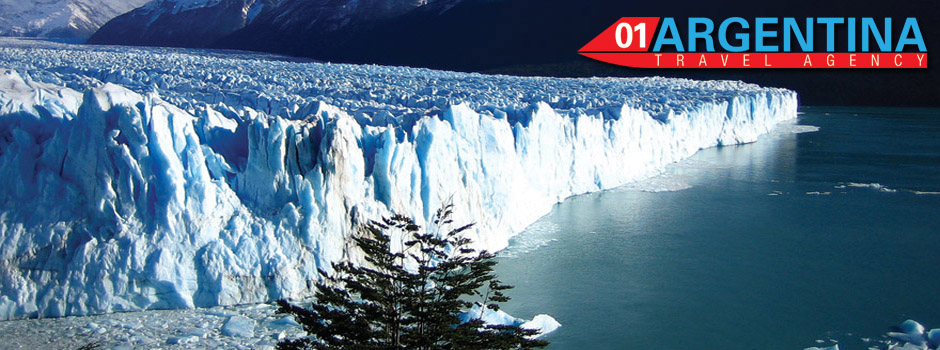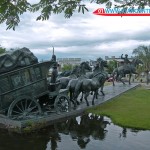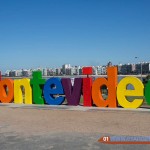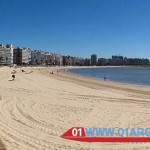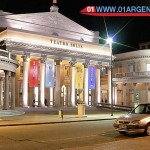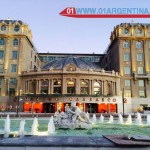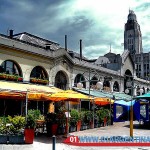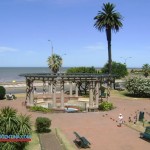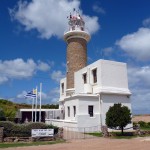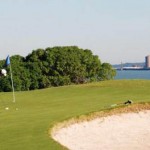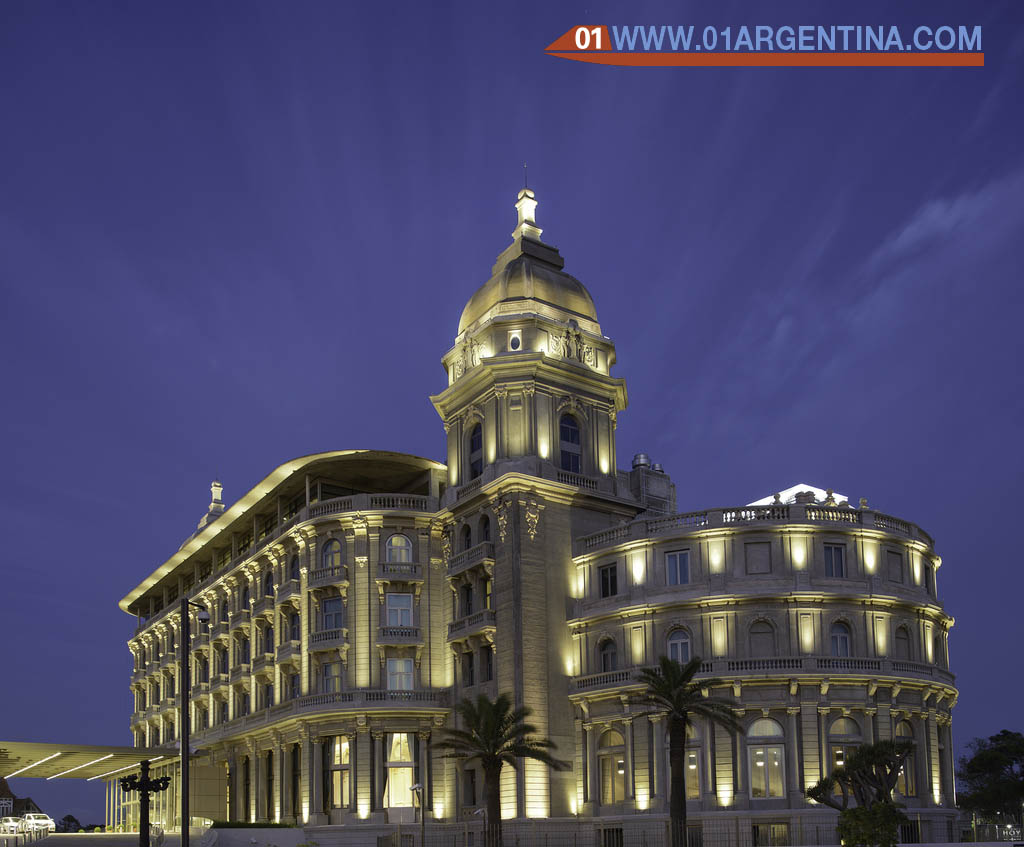 The neighborhoods surrounding the wonderful montevideana coast, and Punta Carretas Parque Rodo are two neighborhoods that attract many visitors, both for its beautiful urban and natural landscapes, and its diversity of cultural offerings. They are considered as one of the most important tourist attractions of Montevideo.
The neighborhoods surrounding the wonderful montevideana coast, and Punta Carretas Parque Rodo are two neighborhoods that attract many visitors, both for its beautiful urban and natural landscapes, and its diversity of cultural offerings. They are considered as one of the most important tourist attractions of Montevideo.
Rambla del Parque Rodo
The promenade and park are the two typical walks in this neighborhood, where the points meet more people, whether montevideanos or tourists.
There on the promenade is the building of the former Park Hotel, opened in 1912, where he currently works as an administrative headquarters of MERCOSUR.
Faced with this old building and a few meters from the sea, the public skating rink where young people attend sports such as skateboarding, longboard, skate and bike stands. His particular view and palm trees complete a unique setting.
Playa Ramirez
In summer sunset contemplation is one of its main attractions. There each February 2 Iemanjá religious holiday where the faithful present offerings to the sea goddess is celebrated. Just a few meters from the beach is the monument to this goddess.
Parque Rodo
It is one of the larger city parks with 43 hectares of green spaces. It has a great diversity of trees surrounding the lake which you can take boat rides pedal. The extensive area of the quarries, the amusement park, the Summer Theater, the Museum of Visual Arts, the Fotogalería open pit and a large number of monuments and works of art are some of its attractions.
Fotogalería opencast
The park has a space for photographic exhibitions Outdoor where
present traveling exhibitions of different artists and themes. You can visit without access limitations and hours every day of the year.
National Museum of Visual Arts
National and international heritage than six thousand works, constitutes one of the most important museum institutions in the country. Exhibits works by Juan Manuel Blanes, Rafael Barradas, Pedro Figari, Jose Cúneo, among other national teachers.
Summer Theatre “Ramón Collazo”
About Rodo Park quarries it is this important stage of Uruguayan culture. There the official carnival competition between February and March, and major shows throughout the year is celebrated. The dome of the stage was remodeled in the style of Eladio Dieste, Uruguayan engineer prominent creator of constructive technology called “armed Ceramics” that was worth international recognition, based on the use of brick in the creation of curved surfaces.
Golf Club
Already in Punta Carretas Golf Club marks the boundary between this district with Rodo Park. It was founded in 1922 in one of the most privileged spots in the city, on the coast of Rio de la Plata. Has a large field of 18 holes spread over 6635 yards. The camp was inaugurated in 1934 with the holding of the second edition of the Open City of Montevideo, and in 1975 was declared a National Historic Landmark.
Zorrilla Museum
On the promenade of Punta Carretas is the former summer home of the poet Juan Zorrilla de San Martin, where now the museum. There, visitors can see furniture, belongings and documents that provide an illustrative journey through the life and times of “Poet of the Fatherland”.
Faro de Punta Brava
In the area known as Punta Brava is the Faro de Punta Carretas where you can see a panoramámica unforgettable view of the coast and the city. The lighthouse can be visited daily from 10 am until sunset.
Punta Carretas Shopping
Opened in 1994, this large mall marked a before and after in the neighborhood.
Its load building with an interesting history, since from 1915 to 1986 worked as a prison. In 1971, in the framework of a troubled era for the country, the spectacular escape of more than 100 prisoners, Tupamaros guerrillas, including the current political renowned Uruguayan political system it took place.
Carrasco circuit
Carrasco was the first case in Uruguayan history of urban planning and design of a whole faced exclusively by private initiative neighborhood. The main bulwark of the dream was the great Hotel Casino Carrasco, a monumental construction style of the luxury hotels of Europe 900. Low buildings and large green spaces are the main features of this neighborhood.
Hotel Carrasco
The landmark building Carrasco Hotel and Casino, which opened in 1921, with high influence of French architecture, is identified with the paradigm of civilization and good taste to the society of the time.
It is located in one of the most beautiful spots in the city. Located opposite the Rio de la Plata, he had ballrooms, game, large dining room and covered terraces and outdoor. A hierarchical haven, away from the bustling city of the 20’s.
After many years abandoned, the building was remodeled and reopened in 2013, returning to the city one of its most heritage buildings and architectural value. Since its reapartura the casino hotel is managed by the international hotel chain Sofitel.
Visitors can enter and meet the hotel lobby every day of the week.
Avenida Arocena
It is the main avenue of the neighborhood and along with its surrounding streets is one of the, ideal for walking most outstanding shopping tours in the area. Over four blocks, Arocena Street houses shops of all kinds as restaurants, ice cream parlors, clothing stores, department stores, supermarkets, banks, among others. In the corner of Rambla is the majestic building of the historic Hotel Casino Carrasco.
Rambla Beach
Given its proximity to the coast and its large dunes, Carrasco began as a peaceful movement away spa town. Currently, the beach and the waterfront promenade in front of the Hotel Carrasco are the most visited places in the neighborhood, especially during seasons where good weather prevails. It is a very busy for the enjoyment and realization of sports and outdoor activities area. On windy days Carrasco beach is a favorite for those who practice Kite Surf.
Circuit Prado
The origins of this neighborhood are closely linked to the founding process of Montevideo, when Captain Pedro Millan spent on farms land adjacent to the Arroyo Miguelete. Over the years this area was marked by summer houses.
Eventually the neighborhood started to become a zone of permanent residence for many families looking to get away from the downtown area of Montevideo. The emerging Eastern patrician of the time he built luxurious villas surrounded by large and neat green spaces, giving rise to the houses fifth. Many of them rooming standing today.
Prado park
Parque del Prado has an area of 106 hectares, around Miguelete stream, which serves as a backbone to walk.
Parque del Prado was in its infancy fifth Jose del Buen Retiro Buschental who commissioned to build a beautiful landscape with trees, flowers and different forest species brought from different countries. The park is crossed by the Arroyo Miguelete, accompanied by the monument to the last Charrúas, the Rose Garden, the Hotel del Prado, the Botanical Garden and the pavilions of the Rural Association.
Rosedal
The Rose Garden, also known as La Rosaleda was inaugurated in 1912 and was established with twelve thousand roses imported from France in 1910. It currently has more than three hundred varieties of ancient and modern roses.
Botanical Garden
The Botanical Garden Museum showcases the flora of the different geographical areas of the world and an extensive display of aquatic plants, plants dry places and shade plants.
It is notable for its important work with regard to teaching botany, serves as a center of scientific activities, as well as, information and training on botany science to the general public.
Residencia de Suárez
It was designed by the architect Juan María Aubriot. From the assumption of Luis Batlle Berres in 1947 he began operating as a rooming house of many presidents of Uruguay, nine the leaders who lived in it. Both the current president, Tabare Vazquez; like his predecessor, Jose Mujica, they decided to live in their own home, dedicating to the residence of Suarez and Reyes to carry out official activities of government.
Blanes Museum
The Blanes Museum is located in a nineteenth-century Palladian villa. Its collection gathers the second most important national art collection, in addition to the personal files of various artists. Exhibits works by Juan Manuel Blanes and Pedro Figari in two permanent galleries; as well as domestic and foreign contemporary artists.
Japanese garden.
Behind the main building of the Blanes Museum is the only Japanese Garden of Uruguay, donated by Japan in 2001 and designed by landscape Haruho Leda.
Pocitos circuit and Diving
Pocitos and Buceo are the most privileged neighborhoods of Montevideo by its geographical location. Located on the Rio de la Plata, these districts combine urban and natural spaces of high architectural and landscape value. Constitute a real live miscellany of buildings, which account for past and present architecture of the city, all this on one of the most magnificent beaches of the capital’s coast.
Beach and Rambla
Rambla de Pocitos is suggested by visitors who have recorrdido walk, and the beach is one of the points that attracts more bathers during the summer.
Poster Montevideo
The poster with the word “Montevideo” located on the Rambla de Pocitos is one of the must-see spots in the neighborhood, where visitors can take pictures accompanied by the spectacular scenery of the pocitense coast.
Naval Museum
This museum tells the story from the sea. Its collection demonstrates the key role it has had on the future of the country its vast maritime borders and the port, determining for the foundation of Montevideo. With this criterion the sample develops the evolution of marine and Navy.
The museum has an access ramp for disabled motor and offers adapted for the blind and information in Braille tour. Furthermore, in its front has park with playground for the kids.
Puertito del Buceo
The Puertito del Buceo is intended for the practice of nautical sports activities. There is the headquarters of the Yacht Club Uruguayo, from where fishing trips and walks. There is Skate Park near Montevideo, next to traditional restaurants and stalls selling fish.
Montevideo Shopping
Located in one of the busiest areas due to commercial activity, the Montevideo Shopping marked a before and an after in the neighborhood. Opened in 1985 and later expanded, the mall has over 180 stores on three levels; ample car parking and green spaces around.
Shopping is next to the World Trade Center complex, consisting of 5 modern towers. At its center has a place in the Sculpture Walk which includes an impressive work by renowned Uruguayan artist, Pablo Atchugarry stands.
Castillo Pittamiglio
Castle is one of the most striking buildings in the Rambla de Pocitos. It was the residence of the architect, engineer and alchemist Humberto Pittamiglio from 1911 to 1966, who remained in permanent construction until the day of his death.
Inside acquires a labyrinthine structure, with multiple rooms and endless nooks and crannies, doors that do not lead anywhere and small stairs, typical of the initiatory temples design.
Plaza Gomensoro
Located opposite the Pocitos beach, this square is characterized by its privileged view of the river. It emerged along with the neighborhood and has maintained its image as an emblematic point of Pocitos. It was built in 1897 with a design consisting of two levels and European-style ornaments.
Villa Biarritz Fair
It takes place on Tuesdays and Saturdays from early morning until 16 pm, in the neighborhood of Punta Carretas. A ride that is worth knowing, has a variety of craft stalls, clothing and accessories, as well as fruits and vegetables.
Check here for more Uruguay Tours and useful information for to travel and visit Uruguay.

